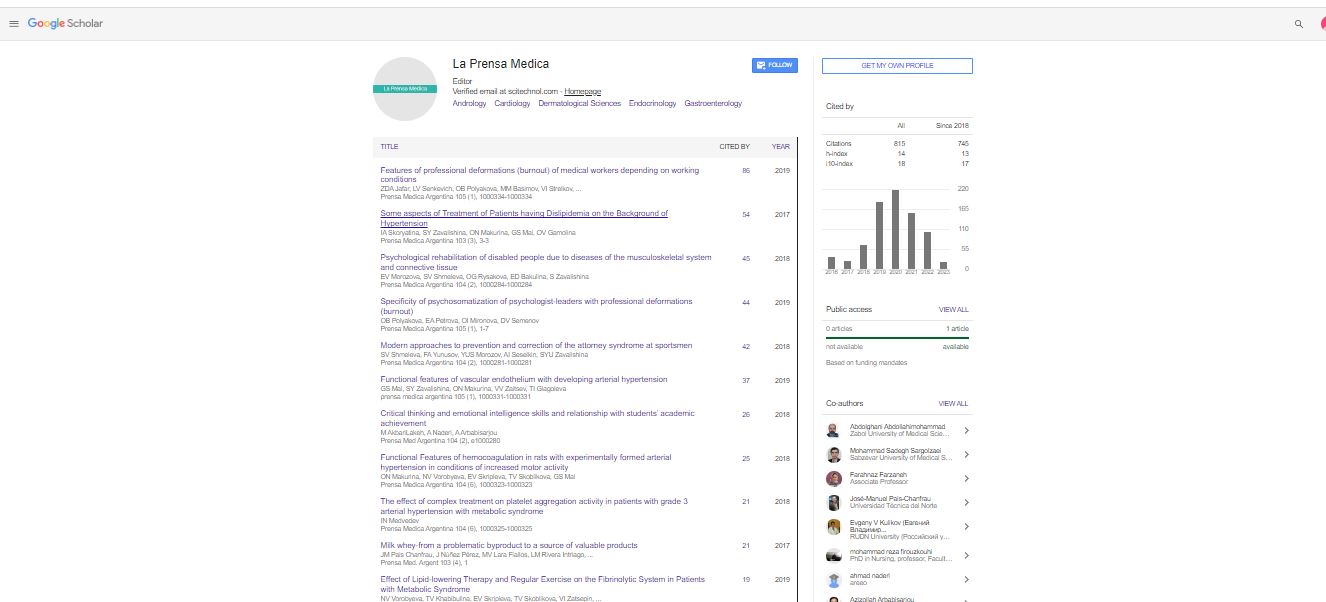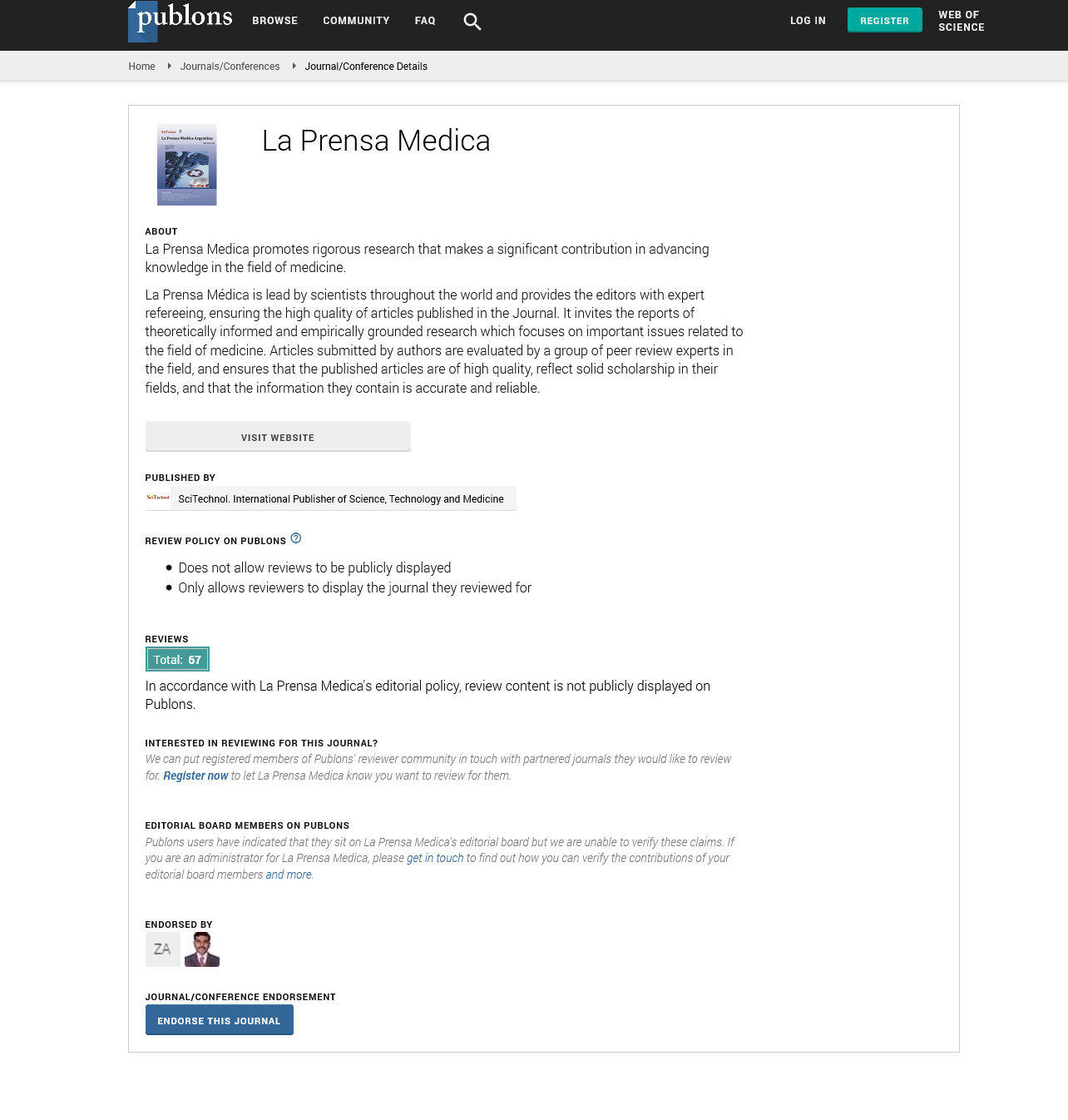Short Communication, La Prensa Medica Vol: 109 Issue: 1
Exploring the Different Subtypes of Parasympatholytic Agents and their Modes of Action
Danys Moes*
1Department of Pharmacological Research, University Medical Center Groningen, 9713 GZ Groningen, The Netherlands
*Corresponding Author: Danys Moes,
Department of Pharmacological Research,
University Medical Center Groningen, 9713 GZ Groningen, The Netherlands
E-mail: moesd71@hotmail.com
Received date: 28 March, 2023, Manuscript No. LPMA-23-100528
Editor assigned date: 31 March, 2023, PreQC No. LPMA-23-100528 (PQ);
Reviewed date: 14 April, 2023, QC No. LPMA-23-100528;
Revised date: 21 April, 2023, Manuscript No. LPMA-23-100528 (R);
Published date: 28 April, 2023, DOI: 10.4172/0032-745X.1000155
Citation: Moes D (2023) Exploring the Different Subtypes of Para Sympatholytic Agents and their Modes of Action. La Prensa Medica 109:1.
Abstract
Description
Para sympatholytic agents, also known as anticholinergics or muscarinic receptor antagonists, are a diverse group of drugs that exert their pharmacological effects by blocking the actions of acetylcholine at muscarinic receptors [1]. These agents have found wide application in various medical fields due to their ability to modulate the parasympathetic nervous system [2]. This commentary aims to delve into the different subtypes of para sympatholytic agents and explore their modes of action, highlighting their diverse therapeutic applications. Muscarinic receptors are classified into five subtypes: M1, M2, M3, M4, and M5. Each subtype has distinct tissue distributions and physiological functions [3].
Para sympatholytic agents can selectively target these subtypes to elicit specific pharmacological effects. For example, M3 receptor antagonists are commonly used to treat overactive bladder, while M1 receptor antagonists have potential applications in cognitive disorders. Selective muscarinic antagonists are designed to specifically target and block a particular muscarinic receptor subtype [4]. For instance, tiotropium, a widely used bronchodilator, exhibits selectivity for M3 receptors in the airways, leading to relaxation of smooth muscles and bronchodilation. Selective antagonists provide a more targeted approach, minimizing off-target effects and improving therapeutic outcomes. Non-selective muscarinic antagonists, such as atropine, block multiple muscarinic receptor subtypes simultaneously [5]. These agents have broader effects on various tissues and systems regulated by the parasympathetic nervous system. Atropine, for example, is used to dilate pupils, reduce salivation, and inhibit excessive gastrointestinal motility. While non-selective antagonists lack specificity, their broad actions can be advantageous in certain clinical scenarios [6].
Para sympatholytic agents exert their effects by competing with acetylcholine for binding to muscarinic receptors [7]. Once bound, these agents prevent the activation of downstream signaling pathways, effectively blocking the actions of acetylcholine. By antagonizing the parasympathetic system, para sympatholytic agents produce a range of physiological responses, including bronchodilation, decreased gastrointestinal motility, decreased secretions, and pupil dilation. The diverse modes of action of para sympatholytic agents translate into a wide range of therapeutic applications. In addition to their use in respiratory disorders like asthma and Chronic Obstructive Pulmonary Disease (COPD), these agents find utility in ophthalmology for mydriasis and cyclopedia during eye examinations or surgeries [8]. They are also used in gastrointestinal disorders to reduce motility and control symptoms like diarrhea. Furthermore, para sympatholytic play a role in the management of overactive bladder, Parkinson's disease, motion sickness, and certain psychiatric conditions [9]. They can be effective in managing certain disorders, it is important to recognize and understand the potential adverse effects associated with their use. One of the most common adverse effects of para sympatholytic agents is dry mouth or xerostomia. By inhibiting the action of acetylcholine, these drugs decrease the secretion of saliva, leading to a dry and uncomfortable sensation in the mouth. This can result in difficulties with chewing, swallowing, and speaking, and may contribute to an increased risk of dental caries and oral infections [10]. Para sympatholytic agents have the ability to cross the blood-brain barrier, leading to various central nervous system effects. These can include confusion, cognitive impairment, drowsiness, and even hallucinations, particularly in older adults. These medications may also exacerbate symptoms in patients with certain psychiatric disorders, such as delirium or dementia.
Conclusion
The potential impact on the central nervous system should be carefully considered when prescribing these drugs, especially in vulnerable populations. Exploring the different subtypes of para sympatholytic agents and understanding their modes of action provides insights into the complex pharmacological effects of these drugs. The selective and non-selective antagonists offer a versatile pharmacological toolbox for clinicians to target specific tissues and systems regulated by the parasympathetic nervous system. As ongoing research unravels the complexities of muscarinic receptor subtypes and their functions, the potential for developing more selective and effective parasympatholytic agents emerges. Further advancements in drug design and selective targeting may pave the way for enhanced therapeutic outcomes and reduced side effects in various medical conditions.
References
- Cormick Mc, David A (1985) Two types of muscarinic response to acetylcholine in mammalian cortical neurons. PNAS 82(18): 6344-6348.
[Crossref][Google Scholar][Pubmed]
- Spicer C, Khwaounjoo P, Cakmak YO (2021) Human and human-interfaced ai interactions: modulation of human male autonomic nervous system via pupil mimicry. Sensors 21(4): 1028.
- Blue EK, ZOE M, Jin Y, Hou L, Robert B et al. (2002) 220-and 130-kDa MLCKs have distinct tissue distributions and intracellular localization patterns. Am J Physiol Cell 282(3): 451-460.
- Felder CC, Frank BP, Ward J, Dellap N (2000) Therapeutic opportunities for muscarinic receptors in the central nervous system. J Med Chem 43(23): 4333-4353.
- Auerbach JM and Segal M (1996) Muscarinic receptors mediating depression and long‐term potentiation in rat hippocampus. J Physiol 492(2): 479-493.
- Wild D, Grove A, Martin M, Eremenco S, McElroy S et al. (2005) Principles of good practice for the translation and cultural adaptation process for patient-reported outcomes (PRO) measures: report of the ISPOR task force for translation and cultural adaptation. Value health 8(2): 94-104.
- Nair VP, Jennifer MH (2004) Anticholinesterases and anticholinergic drugs. Continuing Education in Anaesthesia, Critical Care & Pain 4(5): 164-168.
- Elizabeth HM, Sandor EK, and Steven CS (2005) Comparison of tropicamide and cyclopentolate for cycloplegic refractions in myopic adult refractive surgery patients. J Cataract Refract Surg 31(4): 694-700.
- Dobkin RD, Rubino JT, Menza M, Friedman J, Allen LA et al. (2013) Barriers to mental health care utilization in Parkinson’s disease. J Geriatr Psychiatry Neurol 26(2): 105-116.
- Rohani B (2019) Oral manifestations in patients with diabetes mellitus. World J Diabetes 10(9): 485.
 Spanish
Spanish  Chinese
Chinese  Russian
Russian  German
German  French
French  Japanese
Japanese  Portuguese
Portuguese  Hindi
Hindi 

